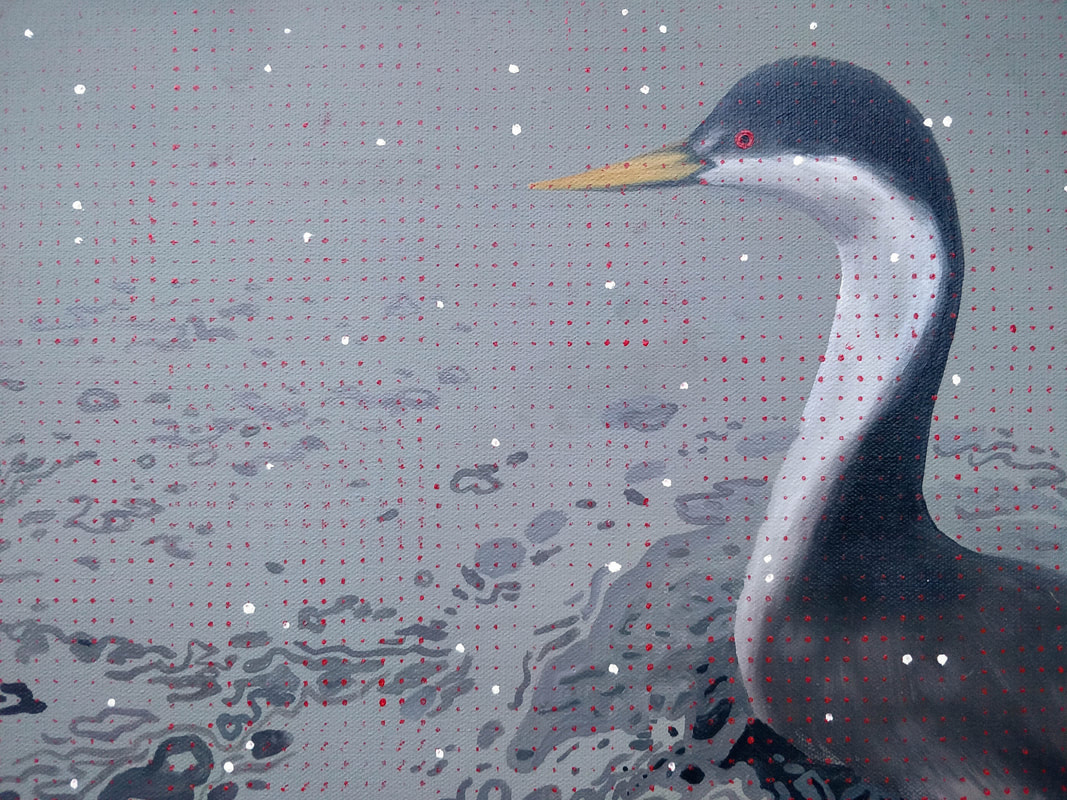Western Grebe Disappearance in Birch Bay
Oil on Canvas
36" x 36"
2020
36" x 36"
2020
Western Grebes are large aquatic diving birds with long, slender necks. In the winter, they migrate to marine waters in large concentrations, and are found during the breeding season in freshwater wetlands. Western Grebes disperse and forage at night, and gather in large flocks during the day. In Bellingham, Western Grebes have historically gathered in flocks numbering in the thousands during the winter. One observer in 1974 documented three thousand Western Grebes, saying the number was not at all unusual in the 1970s (Weber 1974). Nowadays, observers are lucky to see even a few hundred at best. Between the late 1970s to the early 2000s, the combined density of marine birds found in Whatcom County and Puget Sound declined overall, and Western Grebes were some of the hardest-hit species. According to a paper published in 2009, the density of Western Grebes declined from over 50 per square kilometer in 1978/1979 to less than one per square kilometer (Bower 2009). This 98% decline is reflected with 19,150 red dots painted over the Western Grebes in Birch Bay, 383 of which are painted white, to represent the remaining grebes in the area.
Numerous other studies at all seasons have shown an overall decline in Western Grebe populations. There is no singular reason explaining the decline of these grebes, though they are shown to be affected by contamination levels that disrupt endocrine function, oil spills, and habitat degradation. The reproductive success of breeding colonies are especially affected by “wetland draining, pollution and human disturbance” (Bower 2009). Grebes will abandon their nests when disturbed by humans which drastically lowers their reproductive productivity. Restoring Western Grebes to their past abundance would require habitat restoration and protection as well as more research and monitoring of grebe populations.
Numerous other studies at all seasons have shown an overall decline in Western Grebe populations. There is no singular reason explaining the decline of these grebes, though they are shown to be affected by contamination levels that disrupt endocrine function, oil spills, and habitat degradation. The reproductive success of breeding colonies are especially affected by “wetland draining, pollution and human disturbance” (Bower 2009). Grebes will abandon their nests when disturbed by humans which drastically lowers their reproductive productivity. Restoring Western Grebes to their past abundance would require habitat restoration and protection as well as more research and monitoring of grebe populations.
BirdWeb. 2010. “Western Grebe (Aechmophorus occidentalis).” Seattle Audubon Society, https://www.seattleaudubon.org/birdweb/bird/western_grebe. Accessed June 2020.
Bower, J.L. 2009. Symposium Paper: Changes in Marine Bird Abundance in the Salish Sea: 1975 to 2007. Marine Ornithology 37: 9-17.
Bower, John. May 2020. Advising Conversation.
Cornell Lab of Ornithology. 2020. All About Birds. Cornell Lab of Ornithology, Ithaca, New York. https://www.allaboutbirds.org. Accessed June 2020.
eBird. 2020. eBird: An online database of bird distribution and abundance. eBird, Cornell Lab of Ornithology, Ithaca, New York, http://www.ebird.org/map. Accessed June 2020.
Edson, J. M. 1908. “Birds of the Bellingham Bay Region.” The Auk, vol. 25, no. 4, pp. 425–439. JSTOR, www.jstor.org/stable/4070648. Accessed June 2020.
Edson, J. M. 1935. “Some Records Supplementary to the Distributional Check-List of the Birds of the State of Washington.” The Murrelet, vol. 16, no. 1, p. 12. JSTOR, www.jstor.org/stable/3533883. Accessed June 2020.
Nysewander, David R. 2005. “Report of Marine Bird and Marine Mammal Component, Puget Sound Ambient Monitoring Program, for July 1992 to December 1999 Period.” Washington State Department of Fish and Wildlife.
Weber, Wayne. 1974. eBird Checklist: https://ebird.org/checklist/S62186808. eBird: An online database of bird distribution and abundance. eBird, Ithaca, New York, http://www.ebird.org. Accessed June 2020.
Bower, J.L. 2009. Symposium Paper: Changes in Marine Bird Abundance in the Salish Sea: 1975 to 2007. Marine Ornithology 37: 9-17.
Bower, John. May 2020. Advising Conversation.
Cornell Lab of Ornithology. 2020. All About Birds. Cornell Lab of Ornithology, Ithaca, New York. https://www.allaboutbirds.org. Accessed June 2020.
eBird. 2020. eBird: An online database of bird distribution and abundance. eBird, Cornell Lab of Ornithology, Ithaca, New York, http://www.ebird.org/map. Accessed June 2020.
Edson, J. M. 1908. “Birds of the Bellingham Bay Region.” The Auk, vol. 25, no. 4, pp. 425–439. JSTOR, www.jstor.org/stable/4070648. Accessed June 2020.
Edson, J. M. 1935. “Some Records Supplementary to the Distributional Check-List of the Birds of the State of Washington.” The Murrelet, vol. 16, no. 1, p. 12. JSTOR, www.jstor.org/stable/3533883. Accessed June 2020.
Nysewander, David R. 2005. “Report of Marine Bird and Marine Mammal Component, Puget Sound Ambient Monitoring Program, for July 1992 to December 1999 Period.” Washington State Department of Fish and Wildlife.
Weber, Wayne. 1974. eBird Checklist: https://ebird.org/checklist/S62186808. eBird: An online database of bird distribution and abundance. eBird, Ithaca, New York, http://www.ebird.org. Accessed June 2020.






